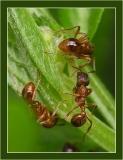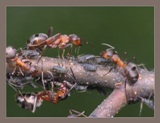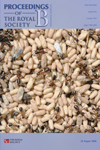|
2. МЕТОДИКА. ЛИТЕРАТУРА. ПОИСК И ОТБОР ДАННЫХ
Авторы максимально широко искали экологическую литературу, исследующую эффекты взаимодействий "муравьи-равнокрылые" в сообществах членистоногих и их растениях-хозяевах, используя стандартные методы поиска по базам данных (Agricola, Biological Abstracts, Science Citation Index). We supplemented our web-based searches by perusing lists of references in relevant published studies. We included studies (both correlative and experimental) that either explicitly tested for the effects of ant–hemipteran interactions or tested more generally for the effects of ants shown to have a positive association with honeydew-producing hemipterans. More explicit selection criteria are described in §§3 and 4.

Тли и Мирмики.
(Фото: П.Корзунович >>>)
3. ВЛИЯНИЕ СИМБИОЗА "муравьи-равнокрылые" на структуру и разнообразие сообщества
Effects of ant–hemipteran interactions on community structure and species diversity
Большинство предыдущих изучений экологических эффектов взаимодействий "муравьи-равнокрылые" фокусировались на нескольких ключевых таксонах и не проверяли эффект влияния на всё сообщество в целом. That hemipteran-tending ants reduce the survival, abundance and alter the spatial distribution of specific natural enemies of hemipterans on plants, for example, is extensively documented (e.g. Bradley 1973; Cushman & Whitham 1989; Tedders et al. 1990; Stechmann et al. 1996; Del-Claro & Oliveira 2000; Kaplan & Eubanks 2002; Renault et al. 2005). Far fewer studies have focused on the effects of ant–hemipteran interactions on other (non-honeydew-producing) herbivores sharing the same host plant, but, in most cases, hemipteran-tending ants significantly reduce their survival and abundance as well (e.g. Nickerson et al. 1977; Messina 1981; Ito & Higashi 1991; Floate & Whitham 1994; Suzuki et al. 2004; Kaplan & Eubanks 2005).
Однако, межвидовые отличия среди фитофагов в их уязвимости к хищничеству муравьев, могут вести к изменениям в общей структуре сообщества (гильдии) фитофагов в присутствии муравьев, разводящих сосущих соки равнокрылых насекомых (Fowler & MacGarvin 1985; Mahdi & Whittaker 1993; Oliveira & Del-Claro 2005). Например, в экспериментальном изучении эффектов лесного муравья Formica lugubris на сообщество травоядных насекомых на березе (Betula pubescens), Fowler & MacGarvin (1985), было обнаружено, что обилие муравьиных тлей Symydobius oblongus, возрастало на 8200% на ветвях с муравьями в сравнении с ветвями, куда доступ муравьям был закрыт. Наоборот, видовое разнообразие сосущих фитофагов (sucking herbivores), которые не продуцировали медвяную росу, сокращалось на 28%, видовое разнообразие листогрызущих гусениц (leaf-chewing caterpillars) редуцировалось на 69% и общее видовое разнообразие фитофагов (herbivore) уменьшалось на 28% на ветвях с муравьями. В другом отдельном обзоре было показано, что видовое разнообразие жуков-листоедов было на 61% ниже на деревьях с муравьями, разводящих тлей. In contrast, species richness of leaf-mining caterpillars, a guild of herbivores that was not vulnerable to ant predation, was actually 44% greater on the trees with aphid-tending ants, presumably because the ants indirectly protected the concealed caterpillars from other predators (Fowler & MacGarvin 1985). Mahdi & Whittaker (1993) documented similar changes in the guild structure of herbivorous insects in a separate study on birch involving another aphid-tending ant, Formica rufa.
Взаимодействия "муравьи-равнокрылые"могут также влиять на структуру муравьиных сообщества на деревьях. Defence of exclusive foraging territories in tropical tree canopies by particularly abundant and aggressive hemipteran-tending ants reduces the density and diversity of other ants, resulting in ‘mosaic’ distributions of ‘dominant’ and ‘sub-dominant’ arboreal ant species (Bluthgen et al. 2000, 2004; Dejean & Corbara 2003). The unique assemblages of dominant and sub-dominant ants among the trees caused at least in part by the availability of hemipteran honeydew probably result in spatially variable effects of those ants on arboreal arthropod communities and on herbivore damage and plant fitness (Bluthgen et al. 2004; cf. Horvitz & Schemske 1984; Dejean et al. 1997a,b). To our knowledge, this has been documented in only one study. In the presence of a honeydew-producing tettigometrid species, tending ants Camponotus brutus effectively excluded several other, normally dominant, ant species that tend scale insects on fig trees (Ficus vallis-choudae) in Cameroon (Dejean et al. 1997a). As a consequence, C. brutus protected figs and their hymenopteran pollinators on tettigometrid-infested trees from predation by the scale-tending ants. However, on the trees without aggregations of tettigometrids, C. brutus was relegated to the role of a sub-dominant ant species by the scale-tending ants, thus affording no indirect protection to fig trees and their pollinators (Dejean et al. 1997a).
Только две работы исследовали влияние эфектов взаимодействий муравьев и равнокрылых на все сообщество членистоногих в целом. Wimp & Whitham (2001) manipulated the presence and absence of the ant-tended aphid Chaitophorus populicola on cottonwood (Populus sp.) trees to test specifically for community-level effects of an ant–hemipteran mutualism. On the trees from which aphids were removed, tending ants Formica propinqua abandoned the trees resulting in a 76% increase in herbivore abundance and a 76% increase in the abundance of generalist predators. Moreover, total arthropod abundance increased by 80% and total species richness increased by 57% on the trees from which aphids were removed. Likewise, a mutualistic interaction between cotton aphids (Aphis gossypii) and red imported fire ants (Solenopsis invicta) strongly affected the abundance and distribution of other arthropods in cotton (Gossypium hirsutum; Eubanks 2001; Eubanks et al. 2002; Kaplan & Eubanks 2002, 2005). In large-scale field manipulations of fire ant densities, the interaction between S. invicta and A. gossypii negatively affected the abundance of 27–33% of herbivore taxa and 40–47% of predator taxa (Kaplan & Eubanks 2005).
Ранее проведенные исследования дают неотразимое свидетельство того, что взаимодействие муравьев и равнокрылых могут быть тем самым краеугольным камнем ‘keystone interactions’, который кардинально и драматически изменяет структуру сообщества членистоногих на растениях. In the presence of honeydew-producing hemipterans, tending ants altered the abundance and distribution of specialist and generalist predators and parasitoids, and multiple species of herbivores in several feeding guilds, resulting in the changes to local species diversity. Though poorly documented, such community-level consequences of ant–hemipteran interactions are probably quite common, particularly for the interactions involving abundant and aggressive ant species. The importance of mutualistic interactions to community structure and diversity has been historically downplayed, however, relative to the effects of competition and predation.

Тли и Мирмики.
(Фото: П.Корзунович >>>)
ч.1 - Введение,
ч.2 - Методика и Влияние симбиоза "муравьи-равнокрылые" на структуру и разнообразие сообщества,
ч.3 - Влияние симбиоза на растения,
ч.4 - А что получают сами растения? Список 11 факторов,
ч.5 - Влияние инвазивных видов муравьев,
ч.6 - Выводы и литература
***
|




